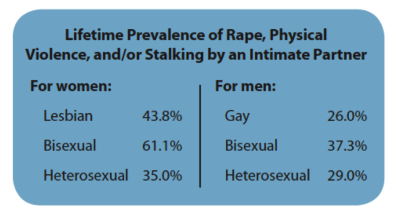Violence Has No Preference
connor.mcgee
What is domestic violence?
Domestic violence, or intimate partner violence, is a complicated issue that plagues all types of people and relationships. The specific definition refers to “a pattern of behaviors utilized by one partner (the abuser) to exert and maintain control over another person (the survivor) where there exists an intimate or dependent relationship”. Acts of domestic violence can come in the form of physical violence, intimidation, threats, isolation, economic abuse, emotional abuse, and entitlement. When we think about what domestic violence means, the first image that often comes to mind is the image of a fragile woman who is in a relationship with a rather aggressive man. And while it is a valid and realistic image, we cannot ignore the evidence that domestic violence is also a problem within homosexual relationships as well. Put into a heterosexual context, domestic violence receives a decent amount of attention. Although there is still much more that could be done, there are currently shelters, therapists, doctors, and programs dedicated to combating it, and reducing its occurrence. Our culture is reluctant to publicize these very same issues that happen within the homosexual community, and yet it is absolutely necessary to do so in order to get a full grasp on the problem that is domestic violence. In order to accurately discuss this, we must acknowledge that domestic violence doesn’t just happen; it is a product of many different factors, comprised of intersecting elements in our society.
Why does domestic violence happen?
Some of the most prominent contributing factors to domestic violence are life stressors. Life stressors can be almost anything stressful that interferes with a person’s routine functioning. Some examples include, but are not limited to; having difficulty in school, being stressed about work, moving, having issues with money, dissatisfaction with a relationship, or even the after effects of previous abuse that the abuser experienced earlier in life. These life stressors tend to frustrate a person so much, that they begin to take out their anger on the person they care about most. Some do not even realize what is happening to their emotional state until they have already acted out their frustrations on their partner in an abusive manner, but are then able to end a cycle of abuse before it continues. Others, however, know exactly what they are doing.
Why do people choose to be abusive to their partners?
Intimate partner violence is not usually an accident, or a state of frustration gone too far; it is more often than not due to an individual’s desire for power and control. Individuals who are most likely to be abusers have often experienced some previous form of abuse, and due to their younger self remembering and modeling that behavior, they end up acting it out later in life, this time with their own partner. They may also suffer from a variety of mental illnesses. Abusers often feel extremely out of control during their earlier years, and because of this they want to be in control of as many elements of their life as possible; especially their romantic partners. Controlling their intimate partners gives them a sense of security, power, control, and even the illusion of true happiness (Island 2012).
Why don’t victims just leave the relationship?
Many people ask those who are being abused why they don’t just leave. A majority of the time the person who is being abused wants to get out of the relationship; however, they may not have the means or power to do so. Abusers often hold control over their victims in as many ways possible, primarily through financial or emotional means that are meant to keep their victims in place. People who are being abused often experience threats if they try to leave, such as threats on their life, or other forms of emotional abuse that are meant to guilt them into staying with their abuser. Some abusers even threaten to hurt or kill themselves if their partner decides to leave.
Why is talking about domestic violence relevant?
Chances are, you probably know somebody who identifies as LGBT who has experienced some form of domestic violence. It is estimated that approximately an average of one in four people are in an abusive relationship at some point in their life. This estimate is probably not very accurate, due to the vast amount of under-reporting that goes on. Men, especially, feel a crushing amount of shame when they become victims of domestic abuse, and are often the least likely to report the incidents. It is very important that we send the message to people of all genders and sexual orientations that they will be well-received if they ever need to get out of an abusive relationship, or report abusive conduct to the police. The intersection of class, gender, and sexual orientation comes into play in so many ways when observing how abuse is dealt with in our society on so many levels, as well as the continuation of the stigmas that surround it.
Society as a whole will need to work together to counter the negative effects of every element of society that causes domestic violence, in order to eradicate it completely.
Sources
All pictures copyright of Google Images.
Domestic Violence Statistics. Men: The Overlooked Victims of Domestic Violence. Department of Justice. 2012. http://domesticviolencestatistics.org/men-the-overlooked-victims-of-domestic-violence/
Journal of Gay and Lesbian Social Services. Shattering Illusions: Same-sex Domestic Violence. Routledge. 2008. http://www.tandfonline.com/doi/abs/10.1300/J041v04n01_01
Island, David. Men Who Beat The Men Who Love Them. Battered Gay Men and Domestic Violence. Routledge. 2012. https://books.google.com/books?hl=en&lr=&id=X4NEAgAAQBAJ&oi=fnd&pg=PP1&dq=gay+men+and+domestic+violence+peer+review&ots=rJyrRDLpxQ&sig=fbX8l8gg-th2Sn78YrjDMdO-9zA#v=onepage&q&f=f
National Coalition Against Domestic Violence. Domestic Violence and LGBT relationships. 2006. http://www.uncfsp.org/projects/userfiles/File/DCESTOP_NOWNCADV_LGBT_Fact_Sheet.pdf


